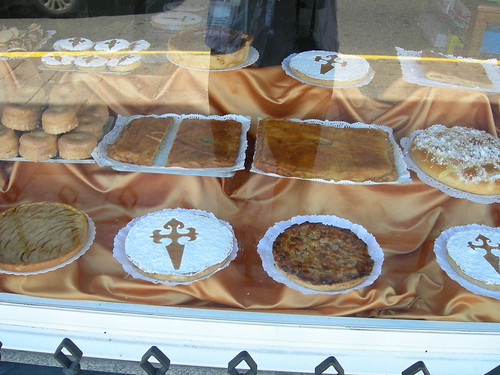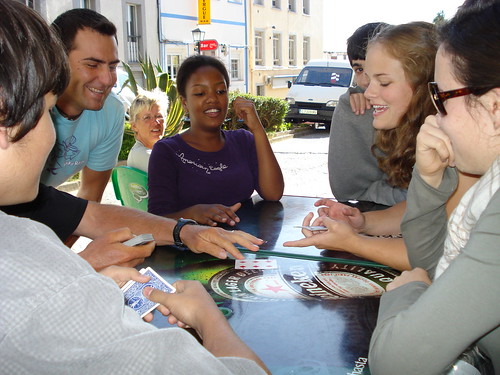
Getting back to the point, Delicioso! The Regional Cooking of Spain
Tarta de Almendra O Merlo
(Galician Almond Cake O Merlo)
There is hardly a restaurant in Galicia that does not offer the region’s traditional almond cake, often called tarta de Santiago because the cross of Spain’s patron saint, Santiago, is usually emblazoned in the cake with caramelized sugar.
Santiago, known in English as the apostle Saint James, was said to have traveled to Spain to preach the Gospel, and after he was martyred in Jerusalem his body miraculously reappeared in Galicia in a field that gradually developed into the glorious city of Santiago de Compostela (see my Discovering Spain: An Uncommon Guide for the full story). Santiago de Compostela became a place of mass pilgrimage in medieval times as millions of Europe’s faithful made the arduous journey on foot to reach the shrine of the Apostle. On of Galicia’s most enduring symbols is the distinctive cross of Santiago.
Tarta de almendra is a single-layer almond cake, simple and moist. Although served as a dessert in Galicia, we would probably consider it more appropriate as a tea cake. One of the best I have eaten comes from Alfonso Merlo, the owner and chef of O Merlo, in the provincial capital of Pontevedra, a restaurant specializing in tapas that are often meal-size. It is a great place to eat when here to visit the city’s quaint Old Quarter and delightful old squares.
Makes one 8-inch cake
6 ounces blanched almonds (about 1 cup)
6 tablespoons flour
¾ cup sugar
3 eggs
Confectioners’ sugar
In a processor, coarsely chop 2 ounces (about 1/3 cup) of the almonds with the flour. Remove from the processor and reserve. Now add to the processor the remaining almonds and ¼ cup of the sugar, and grind the almonds as fine as possible.
In a bowl, with an electric mixer beat the eggs until foamy. Add the remaining ½ cup sugar and beat until the mixture is light-colored and thick. Then beat in the sugar-and-almond and flour-and-almond mixtures. Pour into a greased and floured 8-inch springform pan and bake at 350°F for about 35 to 40 minutes, or until the cake springs back slightly to the touch. Cool, then remove the rim of the pan and sprinkle the cake heavily with confectioners’ sugar.
To burn the traditional cross in the sugar, heat a thin metal skewer (protect your hand with a pot holder) over a flame until the lower portion is red-hot. Press the skewer over the center of the cake to caramelize the sugar. Wipe off the skewer, reheat, and repeat to form a cross.
I never even once saw the cross burnt into the sugar. Never once. No, instead the cross was stenciled on to the cake with powdered sugar.

Oh, the bakery. This bakery was actually in Santiago proper, just as we were walking down the last hill into the center of town. You can see the full-sized cakes, and the smaller cakes. The apple pies. Oh! The donuts! And, dead center, there's even big empanadas.
The Santiago cake (and, yes, I only ever heard it called tarta de Santiago, and never de Almendra) is so very moist. Moist, and dense, and crumbly. I'd serve it with a dollop of stiff whipped cream on the side, and some raspberries or a sprig of mint. Even with the signature dessert of the region, things are kept best when kept simple.
I'll tell you, this goes fine with cider or wine, but I bet it'd also be amazing with some sherry. Or...some kirsch.
I think the first slice I had was in Palas de Rei, right after we met up again with Mr. and Mrs. Belgium. We knew their real names, but as they'd walked out their front door in Belgium months before and just kept walking, we called 'em Belgium. They thought it was funny. We played a mean game of Uno that afternoon, and a meaner game of Bullshit.

The time walking on the Camino was special; the time together in the afternoons and evenings, tired and sharing a new common set of references... it was amazing. I'm feeling all nostalgic; all the youth who went on that pilgrimage with me have graduated, gone off to college... I hope I get to see them when they come back into town for Christmas.
It's not a bad time of year for nostalgia, served up with a slice of cake.
No comments:
Post a Comment